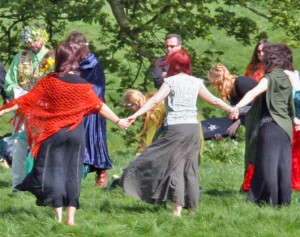A bad ritual. A boring ritual. A confusing, messy time-suck of a ritual. Yeah, you know you’ve been to at least one of those.
Maybe you’ve even facilitated one. I feel you! I’ve been there.
By day I work as an academic librarian–a job that involves a ton of teaching. In my teaching work I use a technique called backward design, in which you decide on your desired outcomes for a class first, followed by how you’ll assess your results, and then the actual content of the class. The process may sound dry on paper, but when used skillfully, it can lead to a really awesome session. Not only that, but it can be adapted to rituals, too!
The process I’m going to describe here lends itself to group rituals, particularly public ones. Be aware, though, that no planning process works equally well across all traditions and ritual types. If this process doesn’t work for you, disregard it!
Intentions and Outcomes
When teaching a class, it’s useful to figure out what you want students to be able to do when the class is over. Explain the causes of World War II? Change the oil in their car? Perform a close reading of a poem? If you haven’t thought about what you expect of your students, then your teaching runs the risk of being vague, unfocused, and ultimately ineffective.
Similarly, when you’re planning a ritual, you should have a clear idea of what you want that ritual to accomplish. Are you strengthening your relationship with a god? Forming a new relationship? Empowering participants to fight injustice? Working a spell? In Truth or Dare, Starhawk writes that “to do ritual, you must be willing to be transformed in some way” (100), and articulating your desired outcomes is how you shape and channel that transformation.
Before we get into outcomes, though, let’s talk about ritual intentions. You could define an intention as the overarching goal or theme that helps organizers plan the ritual and participants work the magic. Jewish intention, or kavanah, is defined as the “direction of the heart.” Reclaiming communities often start the ritual planning process by writing a thoughtful intention. Here are a few examples from Reclaiming LA:
On the cusp of the sun’s rebirth, we gather at the horizon to confront hatred and fear and give rise to love and courage. (Yule 2015)
We proudly declare our unique skills, and witnessed by the divine, we build community. (Lughnasadh 2015)
As the veil thins, we journey into the dark to sing with our ancestors, creating an incantation of peace for our descendants. (Samhain 2014)
A well-crafted intention can lead to a very powerful ritual–but it won’t necessarily get you there on its own. Take, for example, the Yule intention above, which I wrote with another priestess. It’s a great intention, if I do say so myself, but the language leaves some particulars to be fleshed out. How will participants “confront hatred and fear” and “give rise to love and courage?” What will that look like? How will it transform them?
To make sure the ritual was effective, we needed to use our intention as a jumping-off point to craft some specific and concrete outcomes. Since this ritual took place right around when the Syrian refugee crisis reached its height, we decided that in the circle, participants would come to terms with their internalized prejudices and embrace their ability to fight for justice. Although we didn’t use educational terminology to describe it, that was our desired outcome. We didn’t have to have a long discussion about outcomes in order to articulate it–rather, it flowed naturally from our intention.
So how do you come up with a good outcome? One good way to think about it is asking yourself what you want to happen after the ritual. What effect do you want it to have on individuals, your community, or a deity? How do you want the ritual to transform participants and the world through which they move?

Secondly, be mindful of the language you use, even if you’re not writing anything down. Avoid passive or vague verbs and use concrete, active ones instead. “Honor the ancestors” could mean anything. “Build love and gratitude towards the ancestors” is much clearer.
Finally, make sure your outcomes are neither too broad nor too narrow. If your desired outcome for a ritual is “receive abundance,” you might get it in forms you didn’t necessarily want. (This happened to me once–I needed money but ended up with a bunch of free books.) On the other hand, if your outcome is “make this bank give my organization a loan for that space we want to buy,” you may be missing an opportunity to get the money from some other, better source–or to buy another, better space.
Now, rituals can create wonderful altered states and be lots of fun. That’s great! But the downside is that ritual energy can become addictive, and I’ve seen people organize rituals just for the sake of having a ritual. Here’s my personal take on that. If I’m going to put emotional and spiritual energy–not to mention time, of which I have very little–into a rite, then I need to have a clear idea of what that rite will accomplish. This isn’t to say that a spontaneous ritual can’t be powerful…but if you’re going to attempt it, you’d better be a damned good priestess.
Assessment
I won’t lie–assessment gets a really bad rap, and it’s easy to see why. The American education system is obsessed with standardized tests, number-crunching, punitive measures, and homogenization. We “assess” students by demanding that they fit the sum total of their knowledge into a scantron.
But assessment doesn’t have to look like that! Assessment simply means making sure you’ve achieved your desired outcomes. When I teach a class, I assess in lots of different ways. During the class, I keep an eye on students’ faces to make sure they’re engaged and interested. When they’re doing group work, I stroll around and listen to their discussions. After class, I may do something simple like a worksheet or quiz, but I’ll pay more attention to how they integrate the class’s topic into the rest of their academic work. In other words, I keep an eye out for transformations.
Notice that I’m talking about assessment before I get into the heart of the ritual. This is a key feature of backward design. It might seem strange to think about how to assess your ritual before you even know what’s going to happen in it, but trust me, this method can be very effective! It helps you hold yourself accountable to your desired outcomes throughout the entire planning process, rather than tacking assessment on at the end, if at all.
So, ask yourself: how will you assess? You can pay attention to the energy and participants’ demeanors during the ritual (which you should be doing anyway). You can listen closely to what participants tell you afterwards. If they’re praising the ritual (yay!), what exactly are they saying about it? If your ritual honored a deity in some way, you can perform divination or use trance to find out what the deity thought of it. And, of course, if you’re serving a big community, there are always mundane options like surveys or feedback forms.
The most meaningful feedback I ever received was after the Yule ritual I mentioned above. The ritual didn’t go exactly the way I’d hoped and afterwards I felt blue. But then, a participant whom I’d never seen at a ritual before came up to me. She was beaming as she grabbed my arm. “I just want to say thank you,” she said. “Thank you! Thank you!”
That was the first–and, happily, not the last–sign I got that the ritual had been a success.
The Heart of the Ritual
Once you have clear outcomes and you know how you’ll make sure they’re met, planning the ritual itself becomes much easier. In fact, if your outcomes are clear enough, you’ll be amazed at how easily all the details can fall into place.
Since every tradition and ritual is so different, there’s not much I can say that will be widely applicable. I do have one piece of advice, though: Keep it simple.
About a year and a half ago, my ritual planning cell became uncomfortably aware that our rituals had grown rather long. I’m not sure what exactly caused the bloat. Maybe it was a feeling that we owed our community something really spectacular. Maybe, because many of us were new and not totally confident in our priestessing skills, we crammed more activity into our rituals than was necessary. In any case, we decided to cut the length of our rituals in half.
I cannot convey to you what a difference that decision made. Our rituals became, in my opinion, not only tighter and more focused, but much stronger and more memorable. The magic was deeper and more transformative.
If you grew up in a religious tradition that mandated sitting through long services, you know how torturously boring religious ceremonies can be. The longer and more complicated a ritual is–in other words, the more participants have to work just to keep paying attention–the more opportunity the energy has to dissipate. Think of a bubbling pot: if you let it boil too long, the water evaporates and the heat you built up is wasted. The ritual should only last as long as it takes to achieve your outcomes. No longer.*
This means that the ritual’s initial plan shouldn’t include any elements (so to speak) that don’t meet your objectives or can’t be assessed. Of course rituals can take on a life of their own; gods take over, energy flares up, surprising and unexpected things happen. You shouldn’t feel bad if something extra makes its way into your ritual. On the contrary–a simple ritual leaves plenty of room for the unknown! If you over-plan your ritual, you risk producing something stale, but if you start with something simple and let it grow in the moment, you create fertile ground for magic.
What Does This Look Like in Practice?
If your head is spinning, don’t worry. Once you get the hang of backward design, you can integrate it pretty seamlessly into your ritual planning. You don’t have to take extensive notes or write detailed outlines; you just need to be mindful of the ideas above. Let’s take a look at a sample ritual outline:
A Sample Brigid Rite For Your Awesome Community
Intention
With Brigid’s help, we pledge to transform ourselves and our world.
Outcomes
1. Participants will receive useful guidance from Brigid.
2. Using that guidance, participants will be able to make and carry out pledges that have a positive impact on their lives and the world around them.
Assessment
Will participants feel like they had an authentic, meaningful encounter with Brigid? Will they feel confident about their pledges? Will they actually stick to the pledges? We’ll verbally check in with community members 1-2 months after the ritual.
Heart of the Ritual
In a trance journey, participants will ask Brigid where their greatest passion meets the world’s greatest need. Then they’ll ask Brigid how they should put that passion to use. After the trance, participants will announce their pledges to the community, and we’ll seal the spell with a spiral dance and cone of power.
Notice that ritual magic doesn’t have to be complicated! Every year, our Brigid rituals look roughly the same on paper, but every year community members gain new insights. If you’re having a lot of trouble figuring out what to do in a ritual, you may be overthinking it, or your outcomes may still be fuzzy.
You Don’t Have to Use This Process Every Time
In fact, you don’t have to do it at all! (Although if it’s really a turnoff, I’m not sure why you’re still reading this post.) You might find that backward design transforms your whole ritual planning style, or you might find that it gets in the way. Play with it and see!
Happy ritual planning!
What ritual planning methods work for you? Share them in the comments!
Click here to follow Asa West on Facebook, and click here to book a tarot reading!
*Or, as Karina BlackHeart writes of Feri Witchcraft: “Witches gather together in circles and covens to get magical work done. We are martial in that we go in, get the job done and get out” (A Witch’s Book of Silence, 40).












